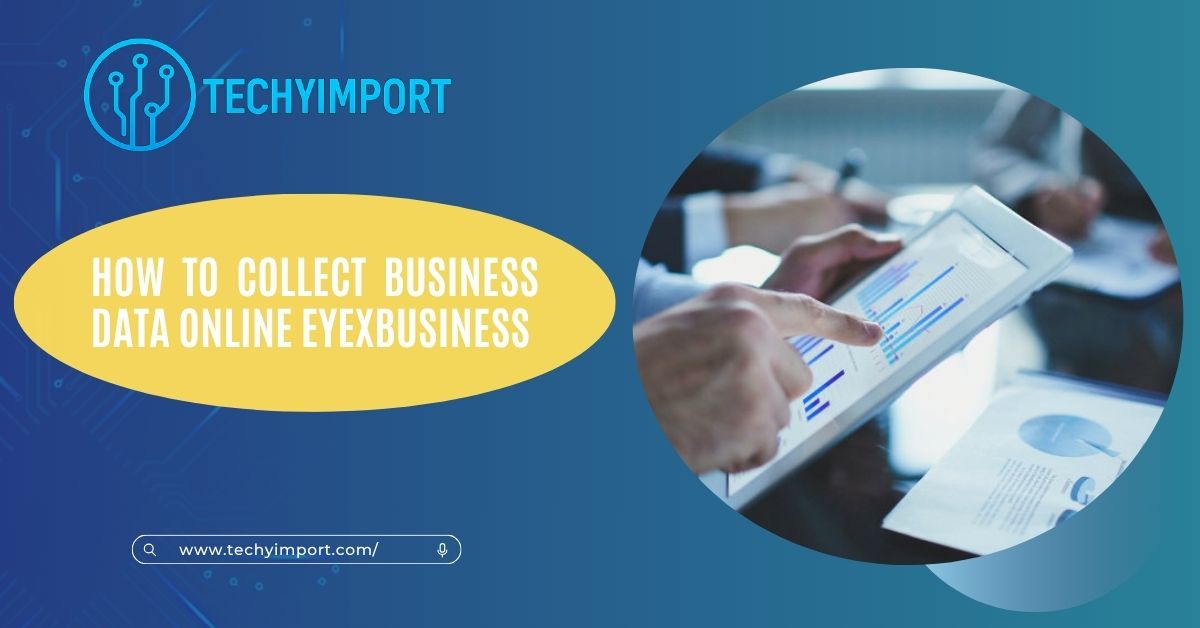I started using the Eyexbusiness method a few months ago to collect data for my small business. At first, I only knew how to check basic social media stats, but Eyexbusiness helped me bring all my data into one place.
Understanding your clients, market, and competitors requires gathering business data online. The Eyexbusiness method uses different online tools to gather and organize this data quickly and effectively.
In this article, you’ll learn easy ways to collect business data online with Eyexbusiness.
Table of Contents
- What is online business data collection – Read out!
- Why is online data collection important for Eyexbusiness?
- How can I find competitor information online – Access your free guide!
- Which free tools help collect business data online – Explore further!
- How do I use social media to collect business data?
- Can I collect customer data legally online – Learn the legal guideline!
- How often should I update my business data – Stay tuned!
- What are the best ways to analyze collected business data?
- How Do I Gather Customer Feedback Online – Engage with us!
- What’s the difference between qualitative and quantitative data?
- How can I improve my business based on online data?
- FAQs:
- Conclusion:
What is online business data collection – Read out!
Collecting information from the internet to better understand your market, clients, rivals, and industry trends is known as online business data collection. This data can come from websites, social media, review sites, public reports, and analytics tools.
Collecting this data helps you make smarter decisions, improve your marketing, and identify new opportunities. For example, by analyzing customer reviews, you can find out what people like or dislike about products. Similarly, tracking competitors’ websites tells you about their pricing and promotions.
Why is online data collection important for Eyexbusiness?
Since online data collecting offers real-time insights into your market, it is essential for Eyexbusiness. You can better customize your goods and services if you know what your clients desire. Understanding competitors’ strategies allows you to differentiate yourself in the marketplace.
Data enables you to spot emerging trends early and make timely adjustments. With online data, you can also measure your marketing efforts and see which campaigns are working. For Eyexbusiness, which likely relies on digital presence, having accurate data means you can optimize your website, social media, and advertising.
How can I find competitor information online – Access your free guide!

Finding competitor information online is easier than you think. Start by visiting their websites to see their products, prices, and special offers. Check their social media pages like Facebook, Instagram, or LinkedIn to see how they engage with customers.
Read customer reviews on review sites like Trustpilot or Google Reviews to understand what people like or dislike. Use web analytics tools like SimilarWeb or Alexa to see how much traffic their websites get and where visitors come from.
Which free tools help collect business data online – Explore further!
- Google Forms: A free tool from Google that allows you to create surveys and questionnaires easily. To get your consumers’ answers, you can send them the link.
- Typeform: This tool helps you make beautiful and easy-to-use forms and surveys. The free version offers basic features, which are good for small businesses.
- SurveyMonkey: A popular free tool for creating surveys. The free plan allows you to make limited surveys with a set number of questions.It facilitates the rapid collection of consumer comments and opinions.
- Microsoft Forms: Similar to Google Forms, this is a free tool from Microsoft. You can easily create forms, quizzes, and surveys that can be shared via email or social media.
- Google Sheets: Not a form tool, but useful for storing and analyzing data collected from other tools. It is simple to use and free for small-scale data collection tasks.
- Facebook Polls: A simple way to gather quick feedback from your followers on Facebook. It’s free and easy to set up.
- Twitter Polls: Use Twitter to create quick polls to understand what your followers think or prefer. It’s free and helps you reach a large audience fast.
How do I use social media to collect business data?
Social media is a treasure trove of information. Start by keeping an eye on what consumers are saying about your company or rivals in order to gather data. Look at comments, reviews, and hashtags to understand customer preferences and pain points.
Use builtin analytics tools like Facebook Insights and Instagram Analytics to see who your followers are, when they are active, and what content they like most. Social listening tools like Hootsuite or Brandwatch can track mentions and sentiment across platforms, giving you a broader view of public opinion.
Can I collect customer data legally online – Learn the legal guideline!
Yes, but it’s crucial to act morally and lawfully.. Laws like GDPR (General Data Protection Regulation) in Europe and CCPA (California Consumer Privacy Act) in the USA set rules for collecting personal data. You must inform customers about what data you collect and how you will use it
Always get explicit permission before collecting personal information through forms or surveys. Avoid collecting data from sources that don’t clearly allow it. Respect user privacy and ensure your data collection practices are transparent.
How often should I update my business data – Stay tuned!

Your industry and objectives will determine how often you should update your company data. For most online businesses, updating key data like website analytics, customer feedback, and competitor activity monthly or quarterly works well.
Frequent updates aid in the early detection of new issues or possibilities. For example, if you notice a new competitor or a shift in customer demand, acting promptly can give you an advantage. Keep your data organized and set reminders for periodic reviews.
What are the best ways to analyze collected business data?
Analyzing business data involves looking for patterns and insights that can guide your decisions. Start by organizing your data in spreadsheets or tools like Google Sheets or Excel. Look for trends such as popular products, peak shopping times, or common customer complaints.
To gain a deeper understanding of the data, use visualization tools such as graphs and charts. For website data, Google Analytics can show how visitors behave and which pages they visit most. Social media insights reveal what content engages your audience.
How Do I Gather Customer Feedback Online – Engage with us!
Use Surveys:
Customer feedback is often gathered through surveys. You can create simple questionnaires asking about their experience, preferences, or suggestions. Use tools like Google Forms or Typeform.
Send Emails:
Email is a direct way to ask customers for their opinions.Send a cordial email requesting feedback following a purchase or service. Include a link to a survey or a feedback form.
Social Media:
Platforms like Facebook, Instagram, and Twitter are great places to gather feedback. You can post questions, polls, or invite followers to comment with their thoughts.
Review Websites:
Ask your customers to leave reviews on websites like Google My Business, Yelp, or Trustpilot. Positive reviews can attract more customers, and negative ones give you ideas to improve.
Live Chat:
Adding a live chat feature on your website allows visitors to share their thoughts instantly. You can ask questions during chat conversations or request feedback after help is provided. This real-time feedback helps you understand customer needs better.
What’s the difference between qualitative and quantitative data?
Qualitative and quantitative data are two types of information that help you understand your business better. Quantitative data is numbers-based, like sales figures, website traffic, or customer ratings on a scale.
Conversely, qualitative data characterizes beliefs, emotions, and driving forces. It includes customer reviews, survey comments, or social media posts. This type of data provides insights into why customers behave a certain way or what they think about your products.
How can I improve my business based on online data?

Using online data effectively can help you make targeted improvements. For example, if data shows that most customers abandon their shopping carts at checkout, you can analyze and fix issues like confusing forms or high delivery costs.
If social media analysis reveals that your audience engages most with videos, focus more on video marketing. Customer reviews can highlight common complaints, helping you address product quality or service issues. Monitoring competitor strategies can inspire new ideas or gaps you can fill.
FAQs:
What is web scraping and is it legal – Request a consultation!
Web scraping is a technique in which data from websites is automatically collected by software. It helps gather large amounts of information quickly, like prices, product details, or reviews. But how you utilize it determines its legality.
How do I track my website visitors – Find out!
Tracking website visitors is essential to understand how people interact with your site. Google Analytics is the most popular free tool for this purpose. It displays the number of visitors you receive, their origins, the pages they view, and their duration of stay.
What is the role of market research in online data collection?
Market research involves gathering information about your industry, competitors, and target customers. Online data collection makes this process easier and faster. It helps you understand who your potential customers are, what they need, and how much they’re willing to pay.
How do I use Google Analytics for business data?
You may track website visitors with Google Analytics, a free service.After installing it, you can see how many people visit your site, which pages they view, how long they stay, and where they come from (e.g., search engines, social media, or direct visits). It also shows the devices visitors use and their geographic locations.
How can I gather industry trends online?
Staying updated on industry trends is vital for business growth. Use Google Trends to see what topics or products are currently popular. Subscribe to industry blogs, newsletters, and online magazines.
Conclusion:
Online consumer feedback collection is simple and crucial for your company.Using surveys, emails, social media, reviews, and live chats helps you understand what your customers like or dislike. These tools are simple to use and don’t cost much.





